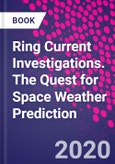Ring Current Investigations offers a comprehensive description of ring current dynamics in the Earth's magnetosphere as part of the coupled magnetosphere-ionosphere system. In order to help researchers develop a deeper understanding of the fundamental physics of geomagnetic storms, it includes a detailed description of energetic charged particles injection, trapping, and loss. It reviews historical and recent advances in observations, measurements, theory and simulations of the inner magnetosphere and its coupling to the ionosphere and other surrounding plasma populations. In addition, it compares the physics of ring currents at other strongly magnetized planets in the solar system, specifically Jupiter, Saturn, Uranus and Neptune, with the ring current system at Earth.
Providing a description of the most important space weather effects driven by inner magnetospheric energetic particles during geomagnetic storms and present capabilities for their nowcast and forecast, Ring Current Investigations is an important reference for researchers in geophysics and space science, especially related to plasma physics, the ionosphere and magnetosphere, solar-terrestrial relations, and spacecraft anomalies.
Please Note: This is an On Demand product, delivery may take up to 11 working days after payment has been received.
Table of Contents
1. Introduction and historical background 2. Observations and Measurement Techniques� 3. Theoretical Description� 4. Modeling Techniques� 5. Ring Current Development� 6. Ring Current Decay
7. Cross-Regional Coupling 8. Space Weather Effects and Prediction 9. Comparative Planetary Ring Currents� Appendix
Authors
Vania K. Jordanova Senior Scientist, Space Science and Applications, Los Alamos National Laboratory, Los Alamos, NM, USA. Vania Jordanova is a senior scientist at Los Alamos National Laboratory with over 25 years of experience bridging theoretical plasma physics, data analysis, and computational modeling. Her expertise includes geomagnetic storm dynamics and processes coupling ionospheric and magnetospheric regions. Originally from Bulgaria, she received a Ph.D. in Atmospheric and Space Sciences from the University of Michigan in 1995. Before joining the Laboratory in 2006, she spent ten years at the University of New Hampshire, teaching magnetospheric physics and investigating the geospace environment with state-of-the-art models she developed. Currently, she is the Chair of the NSF/GEM Program Steering Committee. She has more than 150 scientific publications and has given over 50 invited presentations at international conferences. She is a Co-Investigator on the NASA Van Allen Probes mission and Principal Investigator of the interdisciplinary SHIELDS (Space Hazards Induced near Earth by Large Dynamic Storms) project, winner of a R&D 100 Award in 2017. Raluca Ilie Assistant Professor, Electrical and Computer Engineering, University of Illinois at Urbana-Champaign, Urbana, IL, USA. Prof. Ilie is an Assistant Professor in the Department of Electrical and Computer Engineering at the University of Illinois at Urbana-Champaign. Her primary research is the development and application of high-performance, first principles computational models to describe and predict the conditions in near-Earth space leading to geomagnetic storms.Prof. Ilie's research focus is on developing new approaches to study the dynamics of plasmas and electromagnetic fields in the geospace environment, and to advance the predictive capabilities of the complex dynamics occurring in the solar wind-magnetosphere-ionosphere system. She combines both theoretical and observational work to develop predictive tools that form the basis of operational warning systems and hazard mitigation. Prof. Ilie earned her Ph.D in Space and Planetary Physics from the University of Michigan and has been an NSF Postdoctoral Fellow at Los Alamos National Laboratory. She is a recent awardee of the NSF CAREER, NASA Heliophysics Early Career Investigator and Air Force Young Investigator Program awards. Margaret W. Chen Associate Director, Space Sciences Department, The Aerospace Corporation, Los Angeles, CA, USA. Margaret Chen performs research on charged-particle transport, acceleration, and loss, and wave-particle interactions in the Earth's magnetosphere and ionosphere. Her expertise is on developing and using computer simulation models to understand better the physical processes of such phenomena and has tested simulation results against both theory and observational data. Her work also includes applying space environmental knowledge towards analysis of satellite anomalies. Chen has authored and co-authored over 50 papers in refereed journals. She has served as a Space Science Editor for Geophysics Research Letters (2007-2010) and Editor for the 1996 COSPAR Symposium D0.5: The Subauroral Ionosphere, Plasmasphere, Ring Current and Inner Magnetosphere (Adv. Space Res., 20(3), 1997).







